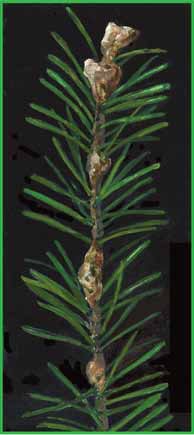
Balsam woolly adelgids (BWA) were first noticed in this country in Brunswick, Maine, in 1908. Like the dreaded hemlock woolly adelgid, this tiny, wingless, introduced insect feeds by inserting its sucking mouthparts into a tree. There are differences between the miniature insects, but the end result is often the same: both have killed millions of very large trees.
BWAs will attack any and all fir trees, but some fir species are more susceptible than others. Fraser fir, a tree of the southern Appalachians, is extremely vulnerable. It grows at high elevations, and in the 1980s most of the mature Fraser fir stands in the Great Smoky Mountains National Park were just about wiped out by BWAs. Fraser fir has a rather small native range, but it’s a staple on many Christmas tree farms, and it gets attacked wherever it’s planted. Fraser fir and balsam fir, the only two fir species in the eastern U.S., are very similar to one another.
Historically, balsam fir has usually survived BWA infestations, although many fir stands in the Northeast were killed in the 1960s and Christmas tree growers are periodically plagued by the disfigured stems and branches that result from BWA feeding. BWAs inject toxins with their saliva as they feed, and this disrupts water and nutrient transport and causes swellings on the small twigs.
Adelgids are often confused with aphids, but aphids are free to walk around on a plant, and they insert their feeding tubes (stylets) wherever they choose. Adelgids can move around only when they are very young, when they are called crawlers. When a crawler inserts its two stylets into the twig or trunk of a tree, it stays there for life. The stylets are several times longer than the animal, but that’s not saying much, as this adelgid is so small that it’s just barely visible without magnification. The woolly part of its name comes from waxy threads it excretes from its back and sides, beginning soon after it begins to feed on a tree. In time, the waxy threads become a visible white tangle of fluff.
Adelgids have complicated life histories and need two different host species to complete their life cycle. In the case of the BWA, one of those species, a spruce native to Europe, is not present in North America. Since this spruce is the host on which sexual reproduction occurs, there are no male BWAs here. Females reproduce asexually, which is known as parthenogenesis. As a result, all of the females in the U.S. are genetically identical – good news for lovers of fir trees because it reduces the chance that the insects will evolve to become yet more deadly.
For the insects, there is a plus side to parthenogenesis. For a fit and capable organism, bypassing mating saves a lot of trouble, and reproduction can proceed at a rapid rate. If things go well for BWAs, each female will lay around 10 eggs a day for 10 days in late spring and, since there are two broods a year, each of those 100 daughters will lay her own 50 or so eggs in late summer.
By the time the crawlers molt a couple of times and become adults, the wooliness is dense enough to hide the insects. If you scrape away the wool, you can see the dark, dark purple adults, pinned to the tree by their stylets, preparing to pump out the next set of eggs. Before long, this exponential growth makes the trunk of a tree look whitewashed. Just imagine 100 to 200 adelgids on a square inch of balsam bark.
Although this insect has coexisted with balsam fir for the past 100 years, recent population increases are a bit worrying. The Vermont Department of Forests and Parks reported a significant increase in BWA damage in 2009 and, in Maine, mortality from BWAs has been on the rise since 2000, mostly within 30 miles of the coast, where it is relatively warm. BWAs don’t like cold winters, and the relatively warm ones of late may be contributing to a rise in their population.
Acid deposition could be playing a role as well. Some researchers believe that trees growing in soil with less calcium are more susceptible to both insects and diseases, and balsam firs tend to compete best in soils that are already somewhat calcium-poor.
In the 1960s a predatory beetle, Laricobius erichsonii, which has an appetite for adelgids, was imported from Europe to deal with the BWA outbreak. The little black beetles were released in nine towns in Vermont, but whether this helped end the outbreak at that time is not known. Another predator, Laricobius nigrinus, from western North America, has recently been released to control hemlock woolly adelgid and some forest entomologists believe it is up to the job. It feeds on BWAs as well – perhaps another reason for optimism.

